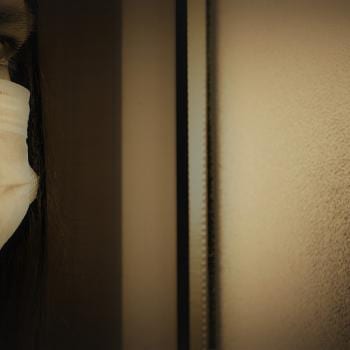The Exaltation of the Holy Cross: how regal, how sonorous, the phrase; how solemn the image, one to which we are accustomed, since any time we walk into a church we see an elevated cross, with the image of a bleeding body on it. Wooden crosses with carved bodies, modern crosses with stylized bodies, Baroque crosses all golden splendor, Medieval crosses with the twisted body and the arcane symbolism of death and birth. We have our different tastes in artistic representation, but one thing is certain, that the crucifix belongs in church, that the cross should be exalted in our worship.
Let’s pause a moment and remember how strange this is. The cross was a shameful symbol at the time, a symbol of criminal execution outside the protective boundaries of citizenship. It was an instrument of torture and the most degrading death. To the people of Jesus’ day, the idea of elevating a cross in worship would have seemed obscene – what today we would consider sado-masochistic, or even nihilistic. The early Christians did not elevate the cross: the signs for our faith in the first and second centuries were doves, ships, lambs, and especially the fish, the ichthus, an acronym for “Jesus Christ, Son of God, Savior.” This doesn’t mean the early Christians were ashamed of the cross, or committed to some naïve prosperity gospel. Too well they knew that following Christ meant, not material abundance, but material loss, suffering, disgrace, death. The cross was revered in the early church, yes, but usually as represented in other shapes: the anchor, the plough. But images of Christ Crucified were not emphasized for several centuries, possibly because the emphasis was on resurrection rather than death (an understandable comfort for persecuted peoples), possibly because of concern about exposing the physical emblem of bodily suffering to a potentially pornographic gaze.
The irony is that American Christians cheerfully wave crosses around, and celebrate emblems of martyrdom, without really understanding the horror entailed. We elevate the cross side by side with the flag, as though it were just another symbol of imperialist domination.
Recently in a Facebook conversation one man boasted about having Maximilian Kolbe’s concentration camp ID number tattooed on his arm. The utter indifference to the atrocity that millions of Jews suffered, the pain and degradation those numbers signify, the trouble survivors went through to have their tattoos erased: this is all ignored, when images of suffering are appropriated and fetishized.
Commodity fetishism in religion: when the images of physical suffering of sacrificial victims are reduced to material commodities that can be purchased, flaunted.
Of course, truly exalting the cross is a lot harder than buying a fancy piece of art, or trendy bling. Truly exalting the cross is damned difficult, and ought to make us stop and ask whether Nietzsche was right about us after all.
As I wrote in an earlier piece, on Good Friday:
In Things Hidden Since the Foundation of the World, Girard goes on to explore what sets the Christian myth apart from others: that the victim in this story is not both sacred and profane. The victim is wholly sacred, and wholly innocent. This is affirmed by the text itself. The resurrection of Jesus is not an external miracle but arises from the internal moral and religious logic of the event.
Unfortunately, for a variety of reasons, this does not mean that people stopped being violent or making scapegoats – Christians are as bad as anyone else about this.
What it does mean is that the whole idea of being a victim has changed. Christianity instituted a profound reversal in set interpretations of value. Whereas before the rich and powerful were given preference, the poor and sick regarded with suspicion, the ethic of the beatitudes mean that we see those who are poor, sorrowful, and oppressed as the “blessed” ones.
To return to Nietzsche: in Genealogy of Morals, he asserts that this reversal arose out of ressentiment, the “creative” rancor that sets up a false value system as an act of revenge. But Max Scheler, responding to this, shows how while Nietzsche is right about ressentiment as a phenomenon that creates false nihilistic values, he is wrong about Christianity. The Christian love of the poor and oppressed victim is not a wallowing in nothingness or weakness, but rather an assertion of the fundamental goodness and dignity of the person no matter what his circumstances. The image of Christ reminds us of this: that the person who on Good Friday was despised and rejected, pierced and defiled, was also completely innocent and completely good.
It is ironic that Nietzsche should have written, earlier, in The Birth of Tragedy, that “the gods justify our existence by living it themselves: the only satisfactory theodicy” – and not notice that Jesus did this, too. Jesus, suffering and innocent, is an advocate for all those who suffer, Jesus suffers with them. No one suffers alone.
Exalting the cross should not be about procuring flashy commodities, though of course beautiful art – and disturbing, grotesque art – can be an important element in our religious experience. Exalting the cross should mean going with Christ into the realm of the outcast, the unseemly, the broken, the shameful – seeking the Christs on the crosses that we have cast out of the respectable places, the Christs on the hills of shame.
Now this date, September 14, has an added significance for me: it’s the anniversary of my first marriage. Fourteen years ago today. The few years in which that marriage lasted were a blend of misery, derangement, delusion, and dark comedy. Blithe Theology of the Body popularizers speak of the marriage bed as the cross, marriage as a crucifixion. They have no idea what they are talking about, because the actual cross was so tormenting, so shameful, that anyone in a marriage that is comparable is justified in doing as I did, and seeking divorce. Yes, marriage is hard; marriage is messy. In that respect, marriage is a little like cleaning out a horse stall. And similarly worth it. Crucifixion is not just hard and messy. It’s a torment beyond what we can imagine. And those who suffer this kind of torment are not usually the ones we are elevating , unless it is after the fact, and we can provide a sanitized, institutionalized version, all the troubling bits cut out. A holy card version.
During my separation and divorce, no one in my parish made any effort to reach out to me. Oh, and this was a progressive parish, by the way. I expected to be shunned and invisible at a traditional parish, but here I found that toleration (like embrace of the cross) is easy in words, often nonexistent in practice. Being a divorced mother in the Catholic church is a lonely business, especially when one is also trying to juggle work and daycare, and deal with all the anger, resentment, and self-loathing that come after a failed marriage. A community that actually exalted the cross might have been one in which I could find healing, but church was just where I went to partake of the sacraments, dubiously, and to glare at well-off yuppie families taking up the cry room in order to gossip about their recent vacations.
Pope Francis has taken a lot of heat for his concern for the state of the divorced Catholics among us. Nitpickers worry that he is somehow going to destroy the faith, but (aside from the silliness of such a fear) what they are missing is that Francis has a heart for those who have indeed experienced something like the cross – something more than just mess and difficulty. People don’t get divorced for shits and giggles. For that matter, neither do people get abortions, or come out as gay, or consider gender reassignment, because they woke up one morning and decided that it would be fun to embrace some narcissistic individualist urge, or kick tradition in the teeth.
Exalting the cross must entail an embrace of those who suffer still, especially those who suffer in ways that seem particularly degrading or shameful, not fit for our respectable flag-waving ceremonies. This can’t become another species of fetishization, either. My progressive parish made a lot of noise about embracing outsiders, but did no such thing. And different communities have different outsiders they prefer to fetishize, so that some may embrace the drug-addicted, or the transgendered, but not the war veteran.
The cross is a paradox and a mystery, as well as a suffering we can barely comprehend. Exalting the cross should not be just an empty gesture or an easy show. I am very uncomfortable with what this means. Ours is not a comfortable religion. Beneath the pop apologies, and the pretty art, this is the hard enduring backbone of our faith: and it endures not so that we have something to flaunt to mark out our space in identity politics or culture wars. It exists for those in the darkest of spaces, where the rest of us would rather not go.
(I totally get why Nietzsche thought we were messed up)











